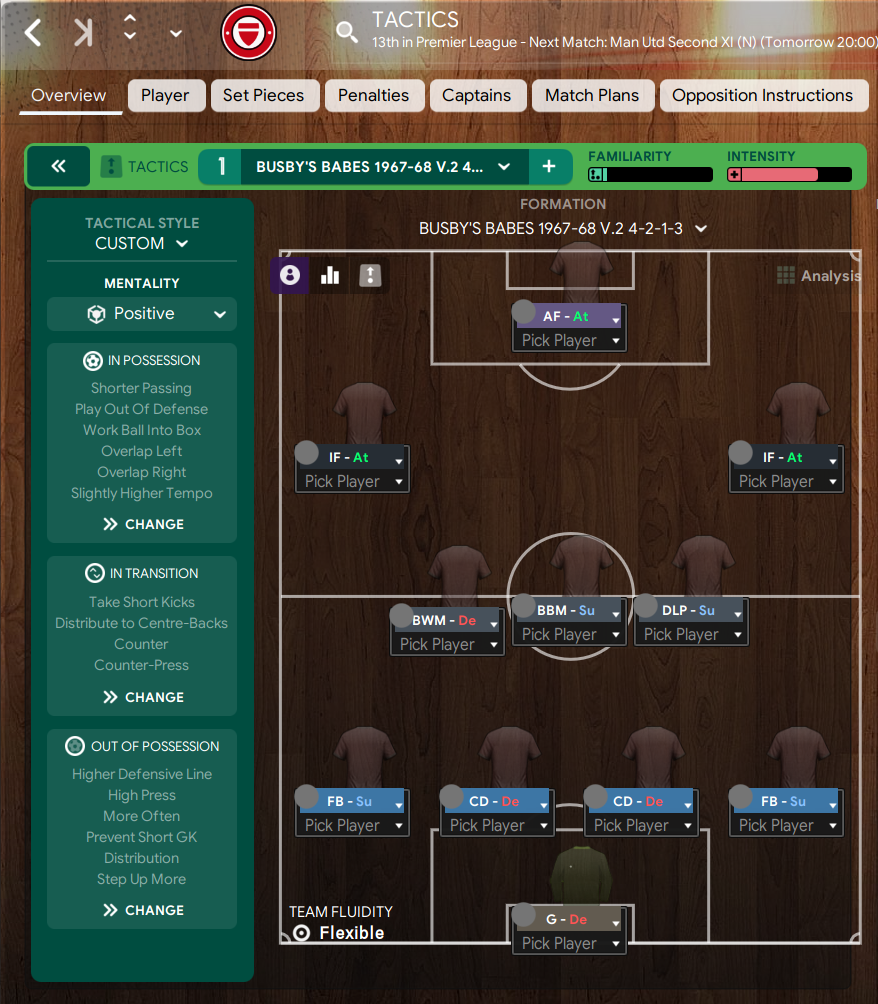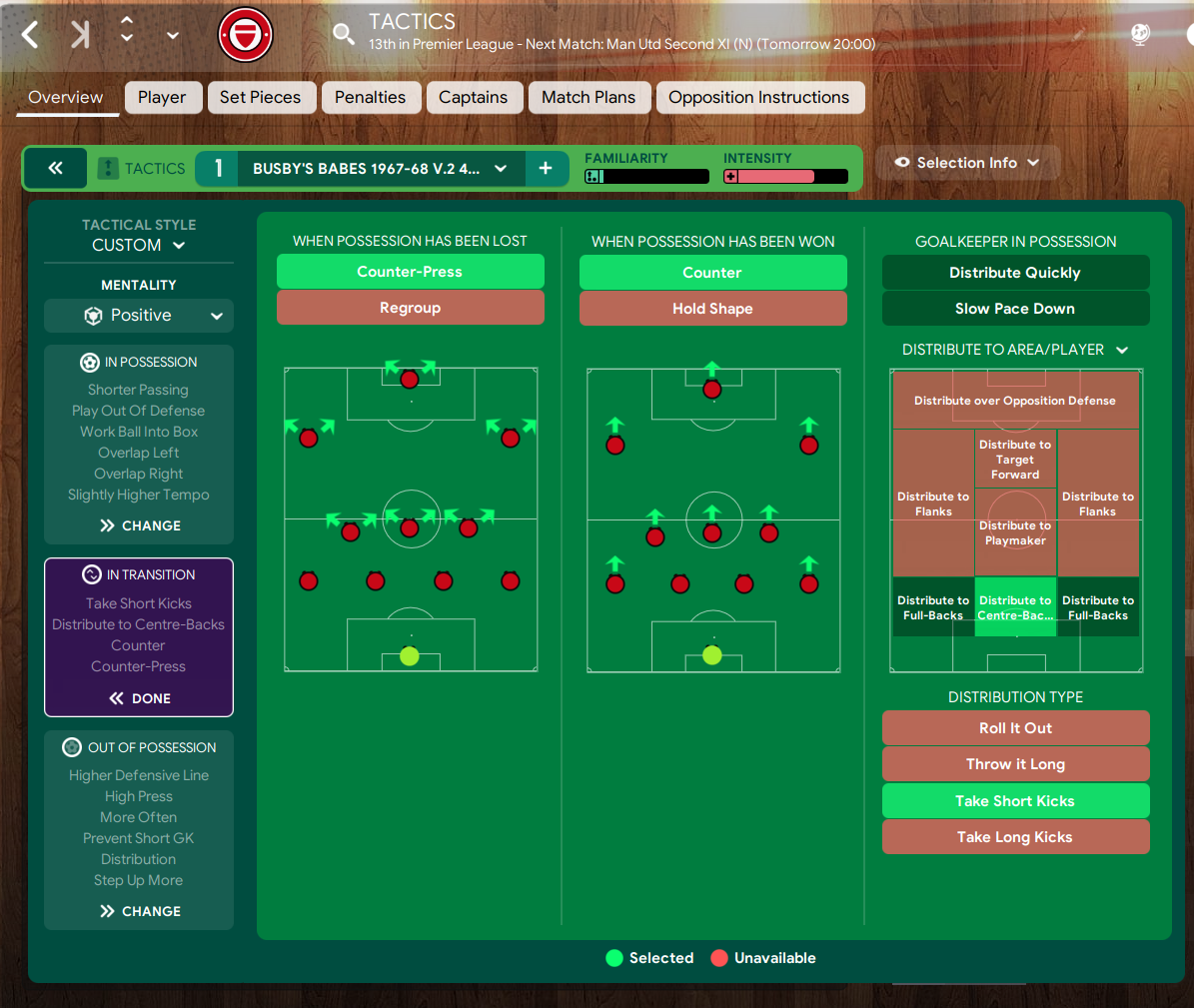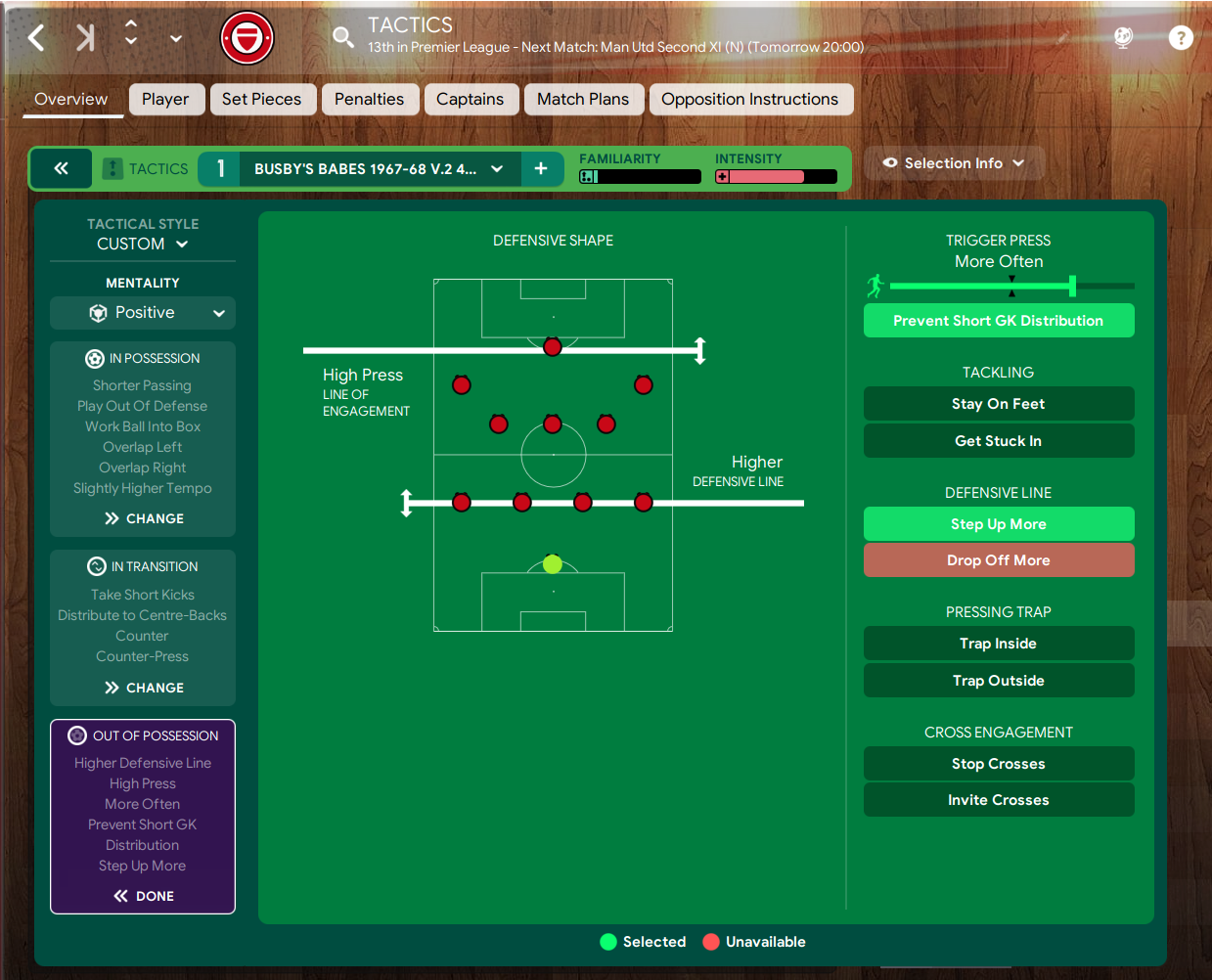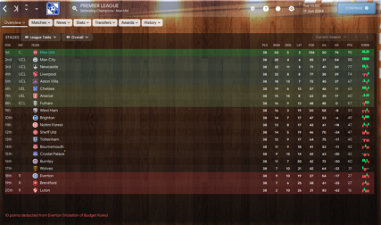| Tester | Team | ME | Win % | PPG | AGF | AGA | GD | PL | W | D | L | |
|---|---|---|---|---|---|---|---|---|---|---|---|---|
| Deleted User #1866315 |
 Manchester (Latacunga)
Manchester (Latacunga)
|
24.2.0 | 79% | 2.5 | 2.7 | 0.8 | 1.95 | 38 | 30 | 5 | 3 |
Matt Busby's Manchester 1967-68 tactic in Football Manager 2024
Sir Matt Busby was born on May 26, 1909, in North Lanarkshire, Scotland.
His journey with the Red Devils began in 1945 when he was appointed as the manager of Manchester United. Nobody did know it, but this was the start of an extraordinary era, the Busby’s babes era, marked by triumphs, setbacks and an indomitable spirit. In the first 13 years of his career, Busby assembled a team of young players, with an average age of 22. The key players were the immensely talented midfielder Duncan Edwards, the striker Tommy Taylor, a real goal-scoring machine, the captain Roger Byrne, a skilled left-back and a great leader on the field and a young Bobby Charlton who, after surviving to the plane crash in Munich, became the most famous English player in history.
This team achieved considerable successes, winning their first-ever First Division title in 1951-52, a FA Cup in 1947-48 and they continued to improve, finishing in the top half of the league every year.
On February 6, 1958, the Red Devils team, along with supporters and journalists, was returning from a Champions League Cup match against Red Star in Belgrade and after stopping in Munich for refueling, the plane failed to take off and crashed into a fence and a house, the impact resulted in a fire and tragically, twenty-three people lost their lives in the crash including eight Manchester United players. Among the fatalities were notable players such as Duncan Edwards, Roger Byrne and Tommy Taylor. Matt Busby was seriously injured but eventually recovered.
Rebuilding the spirit: Matt Busby’s Youthful Revolution
After the devastating Munich plane crash, Matt Busby faced the daunting task of rebuilding Manchester United, and as he did in his pre-Munich experience, he decided to introduce young players and emphasize youth development, this was the start of the well-known “Busby Babes.”
Bobby Charlton, a survivor of the tragedy, become the core of Manchester Utd rebuild under Busby, he became one of the greatest players in the club history, his goal-scoring ability and leadership on the field were pivotal in the team’s resurgence.
George Best, a young and immensely talented winger, became an integral part of Busby’s rebuilt team, adding a touch of brilliance to the attacking lineup.
During an interview, when asked what he said to his players to motivate them before every match, Busby replied: “It’s easy, I tell them to pass the ball to Best as soon as possible, that’s all”.
Denis Law, recruited in 1962, brought experience and goal-scoring prowess to the team, his partnership with Charlton and Best formed a formidable attacking trio.
Busby instilled an attacking philosophy that not only entertained fans but also brought success. The young players played with flair, determination, and a commitment to the attacking traditions of the club.
In season 1962-63, Busby led the team to FA Cup success, which signified a return to glory, followed in season 1964-65 by a First Division title.
Season 1967-68 Champions League winning and Tactical Analysis
Sir Matt switched to a new 4-2-4 formation (often switching to a 4-3-3) in the season 1967-68, when United won the European Cup (now known as the Champions League). In this, most attacks took place in the form of quick, incisive moves through the wings and bombastic movement in the middle.
However, the full-backs would often overlap to add that extra intense pressure to the fray. Charlton, the captain, had the free role of roaming around the final third, Best and John Aston created chances, while Law finished them. Crerand was the “fighter” who helped on the defensive end alongside Nobby Stiles.
With this modified 4-3-3 formation (Charlton was the one who moving forward created a 4-2-4), United ousted Eusebio’s Benfica team in the 1968 final, with Bobby Charlton getting two goals. The Red Devils won it for those who succumbed in the tragedy and did it in the “United way” of exciting, attacking football.
HOW TO EMULATE THIS TACTIC IN FOOTBALL MANAGER 2024
As said in the analysis above, Charlton’s movement influenced the team’s formation, transitioning between a 4-2-4 and a 4-3-3 based on the phase of the game and the tactical needs at that moment. When Charlton pushed forward, the shape changed into a 4-2-4, when the team needed more stability in the midfield or when defending, Charlton might drop deeper into a more traditional central midfield role.
In Football Manager, we will start from the defensive shape, the 4-3-3 and then we will adjust Charlton’s position to allow him to push forward transforming the shape into a 4-2-4 (or a 4-2-1-3 if we want to be more specific).
Despite the emphasis on attacking, Busby understood the importance of a solid defense. Players like Bill Foulkes and Tony Dunne provided stability at the back, balancing the team’s approach. Nobby Stiles, in addition to his midfield role, played a crucial role in providing defensive cover.
For this reason, I prefer to start with a positive mentality, to avoid conceding too many counter-attacks to the opponent.
Team Instructions
- In possession
Attacking width: fairly wide. I did not choose wider or narrower because I want to stick to Busby’s emphasis on both width and central play.
Shorter passing: it encourages quick combinations and fluid movements, which were characteristic of Busby’s attacking style. Besides, this instruction allows my players to build a cohesive attacking unit, with the emphasis on maintaining possession and unlocking defenses through intricate passing sequences. This aligns with Busby’s philosophy.
Slightly Higher Tempo: this instruction encourages my players to move the ball quickly, facilitating swift transitions from defense to attack. It complements the short passing style, allowing my players to maintain a high tempo in their passing sequences. This helps to replicate the dynamic and fast-paced attacking play associated with Busby’s tactics.
Mixed crosses: you can adjust this according to your players' features. If you have players who are good at heading, you can try to use floated crosses to capitalize on their heading ability. If you have fast forwards, you can use whipped crosses to capitalize their pace.
Play out of defense: during Matt Busby’s period at Manchester United, there was an emphasis on building play from the back.
Overlap left and right: as said above, the full-backs would often overlap to stretch the defense.
Work the ball into the box: Busby's Manchester United, particularly during the 1967-68 season, preferred creating chances inside the box rather than relying heavily on shots from outside. The attacking trio of Best, Aston, and Law, along with supporting midfielders, were more inclined towards intricate build-up play, well-timed runs, and combination play in and around the penalty area.
- In transition
Counter-press: during Matt Busby’s era, there was an emphasis on winning the ball back as soon as possible when possession was lost. Busby’s teams were known for their high-energy pressing and quick transitions to regain control of the ball.
Counter: After winning the ball back, Busby's Manchester United often opted for fast counterattacks from high positions. The team capitalized on the element of surprise, exploiting the disorganization of the opposing defense to launch swift attacks and create goal-scoring opportunities.
Goalkeeper instructions: take short kicks and distribute to center-backs to initiate the build-up from the back.
- Out of possession
High pressing line: Busby preferred a relatively high pressing line when out of possession and a proactive defensive style.
Higher defensive line: Busby’s defensive line was set high, this combined with the high pressing line helped to disrupt the opponent’s build-up play and win the ball back in advanced positions. Besides, the team was more compact in this way.
Trigger press: more often. This aligns with the energetic and proactive defensive approach of Busby’s Manchester United.
Step up more: Manchester Utd used the offside trap as part of their defensive strategy.
Prevent short GK distribution
Considering the proactive and aggressive defensive approach associated with Busby’s Red Devils, the instruction “get stuck in” could align with this historical tactic. On the other hand, if your team struggles with discipline, you can remove it.
Other instructions such as trap outside (or inside) and stop crosses (or don’t stop them) are not directly aligned with Busby’s tactic. That’s why I did not select them. The compactness of Busby’s defensive approach based on a high pressing can naturally lead to opponents searching for spaces in wide areas hugging the touchline.
Player instructions
- Defense
Goalkeeper: Alex Stepney: goalkeeper-defend: pass it shorter, take fewer risks.
During that era, goalkeepers were not typically expected to participate extensively in the build-up play as they are in contemporary football. The concept of the “sweeper keeper” as we understand it today was not prevalent.
Right-back: Shay Brennan: full-back-support: stay wider, mark tighter.
Shay Brennan was a traditional right-back, so the full-back role reflects the traditional defensive responsibilities of a right back in that period, focusing on defensive duties with occasional forays forward. The support duty provides a balance between defensive responsibilities and occasional support in the attack and complements the overall team strategy. The stay wider instruction allows the full-back to provide width, in that period full-backs were often instructed to provide width and stretch the opposition defense, allowing the team to exploit space on the flanks and create opportunities for crosses.
Left-back: Tony Dunne: full-back-support: stay wider, mark tighter.
Both Brennan and Dunne were known for their defensive qualities and contributed to the team’s success with their performances.
Right center-back: Bill Foulkes: central defender-defend mark tighter, close down less, take fewer risks.
Left center-back: David Sadler central defender-defend mark tighter, close-down less, take fewer risks.
The two central defenders were traditional defenders who focused on their defensive tasks, and played cautiously to avoid leaving space behind, that’s why you can choose the close-down less instruction, to avoid that your central defenders when trying to press the opponent get lured away from their position.
- Midfield
Defensive midfielder: Nobby Stiles: ball-winning midfielder: stay wider, mark tighter.
Nobby Stiles helped the defense, providing cover for the central defenders from a deeper position and disrupting opposition attacks.
We could choose a central midfielder role for him, and this would surely be a ball winning midfielder with defensive duty. I instructed him to stay wider because I want him to provide cover when the left full-back pushes forward.
Another option could be to put him as an half-back in an asymmetric midfielder shape where he stays more on the left side compared to the other two central midfielders.
Central midfielder: Bobby Charlton: Box-to-Box Midfielder: move into channels, shoot more often, get further forward, pass it shorter.
Bobby Charlton was the key of Manchester Utd’s midfield, when he pushed forward, the Red Devils switched their shape from a 4-3-3 to a 4-2-4 (or 4-2-1-3 with the “1” being Bobby Charlton). The Box to Box midfielder role in Football Manager is a role that has more preset instructions compared to the more editable central midfielder role, besides, the Box- to- Box midfielder comes only with the “support duty”, but by instructing our player to move into channels and get further forward we encourage him to play a more attacking football, finding spaces between the opposition defenders and pushing higher up the pitch during attacking phases contributing more actively to the team’s offensive efforts. If we choose a central midfielder with attacking duty, we may neglect Charlton's ability to contribute to both attacking and defensive phases. If you prefer to use a central midfielder role, then you choose a support duty, but I believe that this does not replicate Charlton’s playing style as well as the box-to-box midfielder role. Lastly, I instructed Charlton to shoot more often, to emphasize his goal-scoring prowess and attacking contributions. He was famous for his ability to score goals from midfield. Having that said, of course you should consider if your midfielders have good values in shooting, at least above 15 (if you play with a lower league team, at least your player should have a value of twelve-thirteen in shooting and long shots).
Right central midfielder: Pat Crerand: deep-lying playmaker-support: pass it shorter.
This role reflects Crerand’s ability to control the tempo of the game, distribute the ball efficiently and provide a link between defense and attack.
- Attack
Right-winger: George Best: inside forward-attack: roam from position, shoot more often.
George Best was a genius, an incredibly dynamic and skillful winger and the inside forward role can be the right choice to replicate his movements.
He loved to use his dribbling ability to take on defenders creating goal-scoring chances for himself or for his teammates. The roam from position instruction allows him to find space and create unpredictable movements. Finally, I instructed him to shoot more often. This instruction aligns with Best's historical playing style as an attacking force who was not only adept at creating chances but also scoring goals himself.
Left winger: John Aston: Inside Forward- Attack: roam from position, shoot more often.
John Aston, while not as prolific a goal-scorer as some of his attacking teammates like George Best and Denis Law, did contribute with goals during his career. His primary role as an Inside Forward, focused on creating opportunities for goals rather than being the main goal-scorer.
Central Forward: Denis Law: Advanced Forward-Attack: roam from position, shoot more often, dribble more (optional, you can choose it according to your striker’s dribbling ability, e.g. high values in dribbling, above 15).
These instructions aim to replicate Denis Law's historical playing style as a center-forward who was not only a goal-scorer but also had the ability to make intelligent runs, create chances, and contribute to the team's attacking dynamics.
Results
Won the Treble (English Premier League -Carabao Cup-UEFA Champions League), best attack in Premier League with 104 goals and best defense with 30 goals allowed. Rasmus Hojlund topscorer with 52 goals in the season 2023-2024 (38 goals in Premier League in 38 apps, 9 in UCL, 5 in Cups).
Test Results
 Manchester (Latacunga)
Manchester (Latacunga)
You'll need to Login to comment




